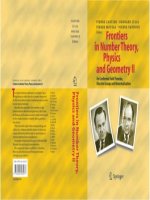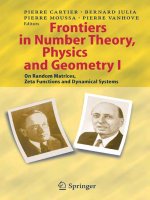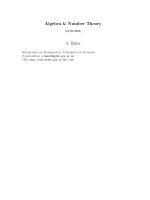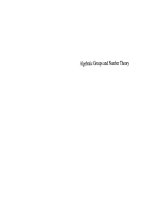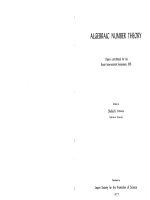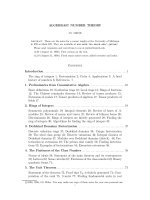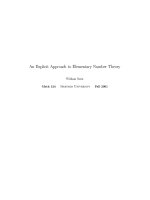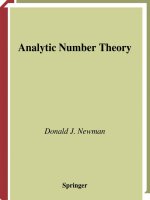elementary number theory - clark
Bạn đang xem bản rút gọn của tài liệu. Xem và tải ngay bản đầy đủ của tài liệu tại đây (452.57 KB, 129 trang )
Elementary Number Theory
W. Edwin Clark
Department of Mathematics
University of South Florida
Revised June 2, 2003
Copyleft 2002 by W. Edwin Clark
Copyleft means that unrestricted redistribution and modification are per-
mitted, provided that all copies and derivatives retain the same permissions.
Specifically no commerical use of these notes or any revisions thereof is per-
mitted.
i
ii
Preface
Number theory is concerned with properties of the integers:
,−4, −3, −2, −1, 0, 1, 2, 3, 4,
The great mathematician Carl Friedrich Gauss called this subject arithmetic
and of it he said:
Mathematics is the queen of sciences and arithmetic the queen of
mathematics.”
At first blush one might think that of all areas of mathematics certainly
arithmetic should be the simplest, but it is a surprisingly deep subject.
We assume that students have some familiarity with basic set theory, and
calculus. But very little of this nature will be needed. To a great extent the
book is self-contained. It requires only a certain amount of mathematical
maturity. And, hopefully, the student’s level of mathematical maturity will
increase as the course progresses.
Before the course is over students will be introduced to the symbolic
programming language Maple which is an excellent tool for exploring number
theoretic questions.
If you wish to see other books on number theory, take a look in the QA 241
area of the stacks in our library. One may also obtain much interesting and
current information about number theory from the internet. See particularly
the websites listed in the Bibliography. The websites by Chris Caldwell [2]
and by Eric Weisstein [11] are especially recommended. To see what is going
on at the frontier of the subject, you may take a look at some recent issues
of the Journal of Number Theory which you will find in our library.
iii
iv PREFACE
Here are some examples of outstanding unsolved problems in number the-
ory. Some of these will be discussed in this course. A solution to any one
of these problems would make you quite famous (at least among mathemati-
cians). Many of these problems concern prime numbers. A prime number is
an integer greater than 1 whose only positive factors are 1 and the integer
itself.
1. (Goldbach’s Conjecture ) Every even integer n>2isthesumoftwo
primes.
2. (Twin Prime Conjecture) There are infinitely many twin primes. [If p
and p + 2 are primes we say that p and p +2aretwin primes.]
3. Are there infinitely many primes of the form n
2
+1?
4. Are there infinitely many primes of the form 2
n
− 1? Primes of this
form are called Mersenne primes.
5. Are there infinitely many primes of the form 2
2
n
+1? Primes ofthis
form are called Fermat primes.
6. (3n+1 Conjecture) Consider the function f defined for positive integers
n as follows: f(n)=3n+1 if n is odd and f (n)=n/2ifn is even. The
conjecture is that the sequence f(n),f(f(n)),f(f(f(n))), ··· always
contains 1 no matter what the starting value of n is.
7. Are there infinitely many primes whose digits in base 10 are all ones?
Numbers whose digits are all ones are called repunits.
8. Are there infinitely many perfect numbers? [An integer is perfect if it
is the sum of its proper divisors.]
9. Is there a fast algorithm for factoring large integers? [A truly fast algo-
ritm for factoring would have important implications for cryptography
and data security.]
v
Famous Quotations Related to Number Theory
Two quotations from G. H. Hardy:
In the first quotation Hardy is speaking of the famous Indian mathe-
matician Ramanujan. This is the source of the often made statement that
Ramanujan knew each integer personally.
I remember once going to see him when he was lying ill at Putney.
I had ridden in taxi cab number 1729 and remarked that the
number seemed to me rather a dull one, and that I hoped it
was not an unfavorable omen. “No,” he replied, “it is a very
interesting number; it is the smallest number expressible as the
sum of two cubes in two different ways. ”
Pure mathematics is on the whole distinctly more useful than ap-
plied. For what is useful above all is technique, and mathematical
technique is taught mainly through pure mathematics.
Two quotations by Leopold Kronecker
God has made the integers, all the rest is the work of man.
The original quotation in German was Die ganze Zahl schuf der liebe Gott,
alles
¨
Ubrige ist Menschenwerk. More literally, the translation is “ The whole
number, created the dear God, everything else is man’s work.” Note in
particular that Zahl is German for number. This is the reason that today we
use Z for the set of integers.
Number theorists are like lotus-eaters – having once tasted of this
food they can never give it up.
A quotation by contemporary number theorist William Stein:
A computer is to a number theorist, like a telescope is to an
astronomer. It would be a shame to teach an astronomy class
without touching a telescope; likewise, it would be a shame to
teach this class without telling you how to look at the integers
through the lens of a computer.
vi PREFACE
Contents
Preface iii
1 Basic Axioms for Z 1
2 Proof by Induction 3
3 Elementary Divisibility Properties 9
4 The Floor and Ceiling of a Real Number 13
5 The Division Algorithm 15
6 Greatest Common Divisor 19
7 The Euclidean Algorithm 23
8 Bezout’s Lemma 25
9 Blankinship’s Method 27
10 Prime Numbers 31
11 Unique Factorization 37
12 Fermat Primes and Mersenne Primes 43
13 The Functions σ and τ 47
14 Perfect Numbers and Mersenne Primes 53
vii
viii CONTENTS
15 Congruences 57
16 Divisibility Tests for 2, 3, 5, 9, 11 65
17 Divisibility Tests for 7 and 13 69
18 More Properties of Congruences 71
19 Residue Classes 75
20 Z
m
and Complete Residue Systems 79
21 Addition and Multiplication in Z
m
83
22 The Groups U
m
87
23 Two Theorems of Euler and Fermat 93
24 Probabilistic Primality Tests 97
25 The Base b Representation of n 101
26 Computation of a
N
mod m 107
27 The RSA Scheme 113
A Rings and Groups 117
Chapter 1
Basic Axioms for Z
Since number theory is concerned with properties of the integers, we begin by
setting up some notation and reviewing some basic properties of the integers
that will be needed later:
N = {1, 2, 3, ···} (the natural numbers or positive integers)
Z = {···, −3, −2, −1, 0, 1, 2, 3, ···} (the integers)
Q =
n
m
| n, m ∈ Z and m =0
(the rational numbers)
R =thereal numbers
Note that N ⊂ Z ⊂ Q ⊂ R. I assume a knowledge of the basic rules of high
school algebra which apply to R and therefore to N, Z and Q.BythisI
mean things like ab = ba and ab + ac = a(b + c). I will not list all of these
properties here. However, below I list some particularly important properties
of Z that will be needed. I call them axioms since we will not prove them in
this course.
Some Basic Axioms for Z
1. If a, b ∈ Z,thena + b, a − b and ab ∈ Z.(Z is closed under addition,
subtraction and multiplication.)
2. If a ∈ Z then there is no x ∈ Z such that a<x<a+1.
3. If a, b ∈ Z and ab = 1, then either a =
b =1ora = b = −1.
4. Laws of Exponents: For n, m in N and a, b in R we have
1
2 CHAPTER 1. BASIC AXIOMS FOR Z
(a) (a
n
)
m
= a
nm
(b) (ab)
n
= a
n
b
n
(c) a
n
a
m
= a
n+m
.
These rules hold for all n, m ∈ Z if a and b are not zero.
5. Properties of Inequalities: For a, b, c in R the following hold:
(a) (Transitivity)Ifa<band b<c,thena<c.
(b) If a<bthen a + c<b+ c.
(c) If a<band 0 <cthen ac < bc.
(d) If a<band c<0thenbc < ac.
(e) (Trichotomy)Givena and b, one and only one of the following
holds:
a = b, a < b, b < a.
6. The Well-Ordering Property for N: Every non-empty subset of N
contains a least element.
7. The Principle of Mathematical Induction: Let P (n)beastate-
ment concerning the integer variable n.Letn
0
be any fixed integer.
P (n) is true for all integers n ≥ n
0
if one can establish both of the
following statements:
(a) P (n) is true if n = n
0
.
(b) Whenever P (n) is true for n
0
≤ n ≤ k then P (n) is true for
n = k +1.
We use the usual conventions:
1. a ≤ b means a<b or a = b,
2. a>b means b<a,and
3. a ≥ b means b ≤ a.
Imp ortant Convention. Since in this course we will be almost exclu-
sively concerned with integers we shall assume from now on (unless otherwise
stated) that all lower case roman letters a,b, ,z are integers.
Chapter 2
Proof by Induction
In this section, I list a number of statements that can be proved by use of
The Principle of Mathematical Induction. I will refer to this principle as
PMI or, simply, induction. A sample proof is given below. The rest will be
given in class hopefully by students.
A sample proof using induction: I will give two versions of this proof.
In the first proof I explain in detail how one uses the PMI. The second proof
is less pedagogical and is the type of proof I expect students to construct. I
call the statement I want to prove a proposition. It might also be called a
theorem, lemma or corollary depending on the situation.
Proposition 2.1. If n ≥ 5 then 2
n
> 5n.
Proof #1. Here we use The Principle of Mathematical Induction. Note that
PMI has two parts which we denote by PMI (a) and PMI (b).
We let P (n) be the statement 2
n
> 5n.Forn
0
we take 5. We could write
simply:
P (n)=2
n
> 5n and n
0
=5.
Note that P(n)representsastatement, usually an inequality or an equation
but sometimes a more complicated assertion. Now if n =4thenP (n)be-
comes the statement 2
4
> 5 · 4 which is false! But if n =5,P (n)isthe
statement 2
5
> 5 · 5or32> 25 which is true and we have established PMI
(a).
3
4 CHAPTER 2. PROOF BY INDUCTION
Now to prove PMI (b) we begin by assuming that
P (n) is true for 5 ≤ n ≤ k.
That is, we assume
2
n
> 5n for 5 ≤ n ≤ k.(2.1)
The assumption (2.1) is called the induction hypothesis.Wewantto
use it to prove that P (n)holdswhenn = k + 1. So here’s what we do. By
(2.1) letting n = k we have
2
k
> 5k.
Multiply both sides by two and we get
2
k+1
> 10k.(2.2)
Note that we are trying to prove 2
k+1
> 5(k +1). Now5(k +1)=5k +5so
if we can show 10k ≥ 5k + 5 we can use (2.2) to complete the proof.
Now 10k =5k +5k and k ≥ 5 by (2.1) so k ≥ 1 and hence 5k ≥ 5.
Therefore
10k =5k +5k ≥ 5k +5=5(k +1).
Thus
2
k+1
> 10k ≥ 5(k +1)
so
2
k+1
> 5(k +1).(2.3)
that is, P (n)holdswhenn = k + 1. So assuming the induction hypothesis
(2.1) we have proved (2.3). Thus we have established PMI (b).
We have established that parts (a) and (b) of PMI hold for this particular
P (n)andn
0
. So the PMI tells us that P (n)holdsforn ≥ 5. That is, 2
n
> 5n
holds for n ≥ 5.
I now give a more streamlined proof.
Proposition 2.2. If n ≥ 5 then 2
n
> 5n.
5
Proof #2. We prove the proposition by induction on the variable n.
If n =5wehave2
5
> 5 · 5or32> 25 which is true.
Assume
2
n
> 5n for 5 ≤ n ≤ k (the induction hypothesis).
Taking n = k we have
2
k
> 5k.
Multiplying both sides by 2 gives
2
k+1
> 10k.
Now 10k =5k +5k and k ≥ 5sok ≥ 1 and therefore 5k ≥ 5. Hence
10k =5k +5k ≥ 5k +5=5(k +1).
It follows that
2
k+1
> 10k ≥ 5(k +1)
and therefore
2
k+1
> 5(k +1).
Hence by PMI we conclude that 2
n
> 5n for n ≥ 5.
The 8 major parts of a proof by induction:
1. First state what proposition you are going to prove. Precede the state-
ment by Proposition, Theorem, Lemma, Corollary, Fact, or To Prove:.
2. Write the Proof or Pf. at the very beginning of your proof.
3. Say that you are going to use induction (some proofs do not use induc-
tion!) and if it is not obvious from the statement of the proposition
identify clearly P (n), the statement to be proved, the variable n and
the starting value n
0
. Even though this is usually clear, sometimes
these things may not be obvious. And, of course, the variable need not
be n. It could be represented in many different ways.
4. Prove that P (n)holdswhenn = n
0
.
5. Assume that P (n)holdsforn
0
≤ n ≤ k. This assumption will be
referred to as the induction hypothesis.
6 CHAPTER 2. PROOF BY INDUCTION
6. Use the induction hypothesis and anything else that is known to be
true to prove that P (n)holdswhenn = k +1.
7. Conclude that since the conditions of the PMI have been met then
P (n)holdsforn ≥ n
0
.
8. Write QED or
or // or something to indicate that you have com-
pleted your proof.
Exercise 2.1. Prove that 2
n
> 6n for n ≥ 5.
Exercise 2.2. Prove that 1 + 2 + ···+ n =
n(n +1)
2
for n ≥ 1.
Exercise 2.3. Prove that if 0 <a<bthen 0 <a
n
<b
n
for all n ∈ N.
Exercise 2.4. Prove that n! <n
n
for n ≥ 2.
Exercise 2.5. Prove that if a and r are real numbers and r =1,thenfor
n ≥ 1
a + ar + ar
2
+ ···+ ar
n
=
a (r
n+1
− 1)
r − 1
.
This can be written as follows
a(r
n+1
− 1) = (r −1)(a + ar + ar
2
+ ···+ ar
n
).
And important special case of which is
(r
n+1
−1) = (r − 1)(1 + r + r
2
+ ···+ r
n
).
Exercise 2.6. Provethat1+2+2
2
+ ···+2
n
=2
n+1
−1forn ≥ 1.
Exercise 2.7. Prove that 111 ···1
n 1’s
=
10
n
−1
9
for n ≥ 1.
Exercise 2.8. Prove that 1
2
+2
2
+3
2
+···+n
2
=
n(n + 1)(2n +1)
6
if n ≥ 1.
Exercise 2.9. Prove that if n ≥ 12 then n can be written as a sum of 4’s
and 5’s. For example, 23 = 5 + 5 + 5 + 4 + 4 = 3 · 5+2· 4. [Hint. In this
case it will help to do the cases n =12, 13, 14,and15 separately. Then use
induction to handle n ≥ 16.]
7
Exercise 2.10. (a) For n ≥ 1, the triangular number t
n
is the number of
dots in a triangular array that has n rows with i dots in the i-th row. Find
aformulafort
n
, n ≥ 1. (b) Suppose that for each n ≥ 1. Let s
n
be the
number of dots in a square array that has n rows with n dots in each row.
Find a formula for s
n
.Thenumberss
n
are usually called squares.
Exercise 2.11. Find the first 10 triangular numbers and the first 10 squares.
Which of the triangular numbers in your list are also squares? Can you find
the next triangular number which is a square?
Exercise 2.12. Some propositions that can be proved by induction can also
be proved without induction. Prove Exercises 2.2 and 2.5 without induction.
[Hints: For 2.2 write s =1+2+···+(n−1)+n. Directly under this equation
write s = n+(n−1)+···+2+1. Add these equations to obtain 2s = n(n+1).
Solve for s. For Exercise 2.5 write p = a+ar +ar
2
+···+ar
n
. Then multiply
both sides of this equation by r to get a new equation with rp as the left hand
side. Subtract these two equation to obtain pr − p = ar
n+1
− a.Nowsolve
for p.]
8 CHAPTER 2. PROOF BY INDUCTION
Chapter 3
Elementary Divisibility
Properties
Definition 3.1. d | n means there is an integer k such that n = dk. d n
means that d | n is false.
Note that a | b = a/b. Recall that a/b represents the fraction
a
b
.
The expression d | n maybereadinanyofthefollowingways:
1. d divides n.
2. d is a divisor of n.
3. d is a factor of n.
4. n is a multiple of d.
Thus, the following five statements are equivalent, that is, they are all
different ways of saying the same thing.
1. 2 | 6.
2. 2 divides 6.
3. 2 is a divisor of 6.
4. 2 is a factor of 6.
5. 6 is a multiple of 2.
9
10 CHAPTER 3. ELEMENTARY DIVISIBILITY PROPERTIES
Definitions will play an important role in this course. Students should learn
all definitions and be able to state them precisely. An alternative way to
state the definition of d | n is as follows.
Definition 3.2. d | n ⇐⇒ n = dk for some k.
or maybe
Definition 3.3. d | n iff n = dk for some k.
Keep in mind that we are assuming that all letters a,b, ,z represent inte-
gers. Otherwise we would have to add this fact to our definitions. One might
also see the following definition sometimes.
Definition 3.4. d | n if n = dk for some k.
Note that ⇐⇒ , iff,andif and only if, all mean the same thing. In definitions
such as Definition 3.4 if is interpreted to mean if and only if. It should be
emphasized that all the above definitions are acceptable. Take your pick.
But be careful about making up your own definitions.
11
Theorem 3.1 (Divisibility Properties). If n, m,andd are integers then
the following statements hold:
1. n | n (everything divides itself )
2. d | n and n | m =⇒ d | m (transitivity)
3. d | n and d | m =⇒ d | an + bm for all a and b (linearity property)
4. d | n =⇒ ad | an (multiplication property)
5. ad | an and a =0=⇒ d | n (cancellation property)
6. 1 | n (one divides everything)
7. n | 1=⇒ n = ±1(1and −1 are the only divisors of 1
.)
8. d | 0(everything divides zero)
9. 0 | n =⇒ n =0(zero divides only zero)
10. If d and n are positive and d | n then d ≤ n (comparison property)
Exercise 3.1. Prove each of the properties 1 through 10 in Theorem 3.1.
Definition 3.5. If c = as + bt for some integers s and t we say that c is a
linear combination of a and b.
Thus, statement 3 in Theorem 3.1 says that if d divides a and b,thend
divides all linear combinations of a and b. In particular, d divides a + b and
a −b. This will turn out to be a useful fact.
Exercise 3.2. Prove that if d | a and d | b then d | a − b.
Exercise 3.3. Prove that if a ∈ Z then the only positive divisor of both a
and a +1is1.
12 CHAPTER 3. ELEMENTARY DIVISIBILITY PROPERTIES
Chapter 4
The Floor and Ceiling of a Real
Number
Here we define the floor, a.k.a., the greatest integer, and the ceiling, a.k.a.,
the least integer, functions. Kenneth Iverson introduced this notation and
the terms floor and ceiling in the early 1960s — according to Donald Knuth
[6] who has done a lot to popularize the notation. Now this notation is
standard in most areas of mathematics.
Definition 4.1. If x is any real number we define
x = the greatest integer less than or equal to x
x = the least integer greater than or equal to x
x is called the floor of x and x is called the ceiling of x The floor x is
sometimes denoted [x] and called the greatest integer function. But I prefer
the notation x. Here are a few simple examples:
1. 3.1 =3 and 3.1 =4
2. 3 =3 and 3 =3
3. −3.1 =-4 and −3.1 =-3
From now on we mostly concentrate on the floor x. For a more detailed
treatment of both the floor and ceiling see the book Concrete Mathemat-
ics [5]. According to the definition of
x we have
x =max{n ∈ Z | n ≤ x}(4.1)
13
14 CHAPTER 4. THE FLOOR AND CEILING OF A REAL NUMBER
Note also that if n is an integer we have:
n = x⇐⇒n ≤ x<n+1.(4.2)
From this it is clear that
x≤x holds for all x,
and
x = x ⇐⇒ x ∈ Z.
We need the following lemma to prove our next theorem.
Lemma 4.1. For all x ∈ R
x −1 < x≤x.
Proof. Let n = x. Then by (4.2) we have n ≤ x<n+1. This gives
immediately that x≤x, as already noted above. It also gives x<n+1
which implies that x − 1 <n,thatis,x − 1 < x.
Exercise 4.1. Sketch the graph of the function f(x)=x for −3 ≤ x ≤ 3.
Exercise 4.2. Find π, π,
√
2,
√
2, −π, −π, −
√
2,and−
√
2.
Definition 4.2. Recall that the decimal representation of a positive in-
teger a is given by a = a
n−1
a
n−2
···a
1
a
0
where
a = a
n−1
10
n−1
+ a
n−2
10
n−2
+ ···+ a
1
10 + a
0
(4.3)
and the digits a
n−1
,a
n−2
, ,a
1
,a
0
are in the set {0, 1, 2, 3, 4, 5, 6, 7, 8, 9}with
a
n−1
= 0. In this case we say that the integer a is an n digit number or
that a is n digits long.
Exercise 4.3. Prove that a ∈ N is an n digit number where n = log(a)+1.
Here log means logarithm to base 10. Hint: Show that if ( 4.3) holds with
a
n−1
=0then 10
n−1
≤ a<10
n
. Then apply the log to all terms of this
inequality.
Exercise 4.4. Use the previous exercise to determine the number of digits
in the decimal representation of the number 2
3321928
. Recall that log(x
y
)=
y log(x) when x and y are positive.
Chapter 5
The Division Algorithm
The goal of this section is to prove the following important result.
Theorem 5.1 (The Division Algorithm). If a and b are integers and
b>0 then there exist unique integers q and r satisfying the two conditions:
a = bq + r and 0 ≤ r<b.(5.1)
In this situation q is called the quotient and r is called the remainder
when a is divided by b. Note that there are two parts to this result. One
part is the EXISTENCE of integers q and r satisfying (5.1) and the second
part is the UNIQUENESS of the integers q and r satisfying (5.1).
Proof. Given b>0andanya define
q =
a
b
r = a −bq
Cleary we have a = bq + r. But we need to prove that 0 ≤ r<b.By
Lemma 4.1 we have
a
b
− 1 <
a
b
≤
a
b
.
Now multiply all terms of this inequality by −b.Sinceb is positive, −b is
negative so the direction of the inequality is reversed, giving us:
b −a>−b
a
b
≥−a.
15
16 CHAPTER 5. THE DIVISION ALGORITHM
If we add a to all sides of the inequality and replace a/b by q we obtain
b>a− bq ≥ 0.
Since r = a − bq this gives us the desired result 0 ≤ r<b.
We still have to prove that q and r are uniquely determined. To do this
we assume that
a = bq
1
+ r
1
and 0 ≤ r
1
<b,
and
a = bq
2
+ r
2
and 0 ≤ r
2
<b.
We must show that r
1
= r
2
and q
1
= q
2
.Ifr
1
= r
2
without loss of generality
we can assume that r
2
>r
1
. Subtracting these two equations we obtain
0=a −a =(bq
1
+ r
1
) −(bq
2
+ r
2
)=b(q
1
−q
2
)+(r
1
− r
2
).
This implies that
r
2
− r
1
= b(q
1
− q
2
).(5.2)
This implies that b | r
2
−r
1
. By Theorem 3.1(10) this implies that b ≤ r
2
−r
1
.
But since
0 ≤ r
1
<r
2
<b
we have r
2
−r
1
<b. This contradicts b ≤ r
2
−r
1
. So we must conclude that
r
1
= r
2
. Now from (5.2) we have 0 = b(q
1
−q
2
). Since b>0 this tells us that
q
1
−q
2
=0,thatis,q
1
= q
2
. This completes the proof of the uniqueness of r
and q in (5.1).
Definition 5.1. An integer n is even if n =2k for some k,andisodd if
n =2k +1forsomek.
Exercise 5.1. Prove using the Division Algorithm that every integer is either
even or odd, but never both.
Definition 5.2. By the parity of an integer we mean whether it is even or
odd.
Exercise 5.2. Prove n and n
2
always have the same parity. That is, n is
even if and only if n
2
is even.
17
Exercise 5.3. Find the q and r of the Division Algorithm for the following
values of a and b:
1. Let b =3anda =0, 1, −1, 10, −10.
2. Let b = 345 and a =0, −1, 1, 344, 7863, −7863.
Exercise 5.4. Devise a method for solving problems like those in the previ-
ous exercise for large positive values of a and b using a calculator. Illustrate
by using a = 123456 and b = 123. Hint: If a = bq + r and 0 ≤ r<bthen
a
b
= q +
r
b
and so
r
b
is the fractional part of the decimal number
a
b
.Soq is
what you get when you drop the fractional part. Once you have q you can
solve a = bq + r for r.
Sometimes a problem in number theory can be solved by dividing the integers
into various classes depending on their remainders when divided by some
number b. For example, this is helpful in solving the following two problems.
Exercise 5.5. Show that for all integers n the number n
3
− n always has 3
as a factor. (Consider the three cases: n =3k, n =3k +1,n =3k +2.)
Exercise 5.6. Show that the product of any three consecutive integers has
6 as a factor. (How many cases should you use here?)
Definition 5.3. For b>0 define a mod b = r where r is the remainder given
by the Division Algorithm when a is divided by b,thatis,a = bq + r and
0 ≤ r<b.
For example 23 mod 7 = 2 since 23 = 7 · 3+2and−4mod5=1since
−4=5·(−1) + 1.
Note that some calculators and most programming languages have a func-
tion often denoted by MOD(a, b)ormod(a, b) whose value is what we have
just defined as a mod b. When this is the case the values r and q in the
Division Algorithm for given a and b>0aregivenby
r = a mod b
q =
a −(a mod b)
b
If also the floor function is available we have
r = a mod b
q = a/b
